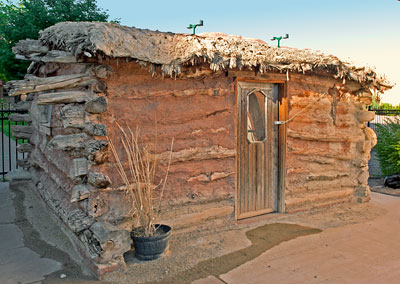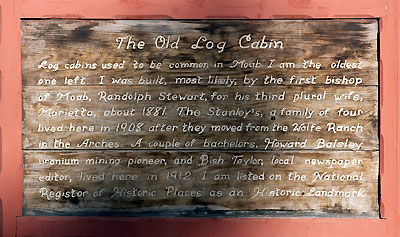National Register of Historic Places in Grand County
 The Moab Cabin was moved from its original location to a historic complex which also contains
the Moab LDS Church and the commemorative plaque for the Elk Mountain Mission Fort.
The Moab Cabin was moved from its original location to a historic complex which also contains
the Moab LDS Church and the commemorative plaque for the Elk Mountain Mission Fort.
 The Old Log Cabin
The Old Log Cabin
Log cabins used to be common in Moab. I am the oldest one left. I was built, most likely, by the first bishop of Moab, Randolph Stewart, for his third plural wife, Marietta, about 1881. The Stanley's, a family of four lived here in 1908 after they moved from the Wolfe Ranch in the Arches. A couple of bachelors, Howard Balsley, uranium mining pioneer, and Bish Taylor, local newspaper editor, lived here in 1912. I am listed on the National Register of Historic Places as an Historic Landmark.
24 June 2011
(Click Photos to Zoom)
Moab Cabin
65 North 200 East
Moab
Built c.1881
The following anecdotes about some of the people who lived in the Moab Cabin are excerpted from the NRHP nomination dated 17 December 1979:
R. H. Stewart and His Three Families
In 1879 R. H. Stewart and his three families started south from Rich County, Utah in response to a call of the Mormon Church to settle Emery County (which then included the present Grand County). They were stopped by the fierce winter of 1879-80 in Huntington where Bishop Stewart built three log houses for his families. They stayed in Huntington for one year and then continued on to Moab where he acquired the original site of this cabin and deeded it to Marietta his third wife who later sold it to John Jackson.
John Jackson and His Family
Some say Stewart built the cabin, others say Jackson built it of cottonwood logs hauled from the creek that ran through Moab. Jackson was a Wild West, yarn-spinning, old-time cowboy who had been raised in Texas, orphaned at eleven, lived with an uncle for a time and got in several scrapes with other cowboys, Indians, and horse thieves. Jackson claimed that when he left Texas, the sheriff and his possee wanted him to stay so bad they chased him all the way to the border, trying to get him to come back.
In 1891, Jackson drifted up to Moab from Arizona, spent a night or two, and did not return until 1893, when he got his start as a cattleman by roping wild mavericks and selling them for five dollars a head eventually becomin a wealthy cattlemanman. During his days on the range he usually kept his wife and family with him. While in town, they stayed in the cabin. Jackson's first wife, Lillian Webb, bore at least one of her children in the cabin.
Howard W. Balsley and Bish Taylor
In 1911 Howard W. Balsley purchased the cabin and has owned it ever since. [Webmaster note: When this nomination was written in 1979, Balsley was 92 and was the second oldest person in Moab.] Balsley lived in the cabin for a short while with his friend, Loren L. "Bish" Taylor, who became the second owner and editor of the Moab newspaper, The Times Independent. The two men lived here only a short time while they built a frame structure directly to the south; it had room for some cupboards and was generally more spacious. (This frame dwelling is now [1971] part of the main structure of the "Atomic Motel.")
Balsley's Parents Balsley's parents came out for a visit in 1910 and stayed almost a year in the cabin. Balsey's father put a glass window in the front door, apparently the only alteration in the building since its construction.
Tom Trout, Balsley's Father-in-Law
In 1912, Balsley married Jessie Trout, a local girl whose father, Tom Trout, was one of the wild Texas cowboys to settle in the Moab area. Tom Trout lived in this cabin for three or four years before his death on July 15, 1939. Trout had run cattle in Texas and participated in the big cattle drives to Dodge City, Kansas. At Christmas 1886, Trout came to Moab to celebrate (in the hard-drinking, gun-shooting manner of the wild west cowboy) and won ten dollars on the horse race held on Moab's main street. Trout soon left Moab but returned in 1888. He married Elizabeth Standifird of Moab, became a cattle rancher, county road commissioner, deputy sheriff, and miner.

Buildings that Moved
It's not just that the people of the American West are restless, the buildings themselves sometimes pack up and move when - for one reason or another - the neighborhood no longer suits them or the neighbors no longer want them or opportunity waits down the road.
And when buildings remain in place, they are often searching for their identities.
Acting Superintendent's Office, Yosemite
Alford-Nielson House, Ferndale
Alpine Hotel, Markleeville
Ashland Depot Hotel, Ashland, Oregon
Auburn Fire House No. 1, Auburn
Bagby Stationhouse, El Portal
Bayview Hotel, Aptos
Bridgeport Elementary School, Mono County
Calvary Presbyterian Church, Bolinas
Carter House, Ashland, Oregon
Christian Church, Gilroy
Choller Mansion, Virginia City, NV
Chuck's Railroad Room, Westwood
Colfax Freight Depot (Moved Twice), Colfax
Commodore Watkins House, Atherton
Coyle-Foster Barn, Shasta State Historic Park
Croll Building, Alameda
Dallam-Merritt House, San Francisco
Davis Creek Community Church, Davis Creek
Duatre's Store, Monterey
Errea House, Tehachapi
Fairwind, Eureka
First Baptist Church, Sonoma
Fort Bragg Storehouse and Commissary, Fort Bragg
Galarneaux House, Sacramento
Glass House, San Ramon
Glendale School (Moved Twice), Sparks, Nevada
Goleta Depot, Goleta
Gray's Station, Truckee
Hostess House, Palo Alto
Hodgdon Homestead Cabin, Yosemite
House at 2214 Clay Street, San Francisco
Hutton House, Saratoga
Independence Hall, Woodside
J & T Basque Restaurant, Gardnerville, NV
Jamestown Branch Jail (Moved Twice)
Jax Truckee Diner (Moved Twice), Truckee
Jorgensen Studio, Yosemite
King City Depot, King City
La Gloria Schoolhouse, King City
Lagunita Schoolhouse, Salinas
Lake Mansion (Moved Twice), Reno
Lathrop House, Redwood City
LeConte Memorial Lodge, Yosemite
Little Church on the Hill, Oakhurst
Mansion House Hotel, Watsonville
Marcus Books and Jimbo's Bop City, San Francisco
McCredie House, Central Point, Oregon
Meherin House, Pismo Beach
Mendocino Masonic Hall, Mendocino
Methodist Episcopal Church, Placerville
Migliavacca Mansion, Napa
Milton Masonic Hall, Milton
Moab Cabin, Moab, Utah
Old North San Juan School, North San Juan
Rengstorff House, Mountain View
Sylvester House , San Francisco
United Methodist Church, Nevada City
Mt. Buckingham School, Darrah
Old Log Jail (Moved Twice), Markleeville
Old Mammoth Saloon (Moved Twice), Mammoth Lakes
Old St. Mary's Church, Rocklin
Old St. Patrick's Church (Moved Twice), San Francisco
Perry's Dry Goods, Gardnerville, NV
Phelps House (Moved Twice), San Francisco
Reno Arch (Moved Five Times), Reno
Roper House, Ashland, Oregon
San Rafael Improvement Club, San Rafael
St. James Catholic Church, Georgetown
Tribune-Republic Building, San Luis Obispo
Tubbs Cordage Company, San Francisco
Tucker House, Martinez
Twenty Mile House, Cromberg
Webber House, Yountville
Wood House, Modesto
Yosemite Transportation Company
Yosemite Valley Chapel
Of the buildings and structures we have visited, the original Reno Arch holds the record for number of moves. It has been moved five times since it was built in 1926.
Jax Truckee Diner holds the distance title. The building moved from New Jersry to Pennsylvanis in 1948, then from Pennsylvania to Califonia in 1992.
Probably the most ambitious relocation occurred on July 4th 1904, when the Southern Pacific Railroad loaded most of the town of Wadsworth, Nevada, onto rail cars and transported the town thirty miles west to create a new town which became known as Sparks.